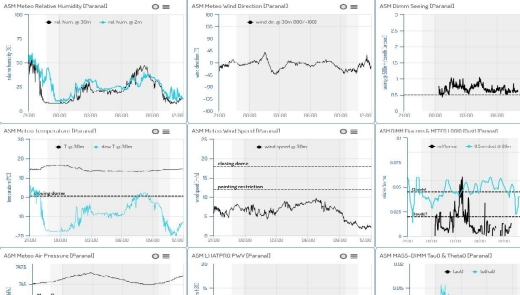The ESO astronomical site monitor (ASM) system on Paranal has undergone a major overhaul. This upgrade was required due to hardware and software obsolescence and the demands of the Adaptive Optics Facility (AOF) to measure additional atmospheric properties (altitude of atmospheric turbulence along the observing path). This upgrade also includes a new display tool of the ambient conditions.
Upgrade of the Paranal Astronomical Site Monitor

Since the expected improvement in the science image quality brought by AOF will be strongly dependent on the vertical distribution of the atmospheric turbulence, a priori knowledge of this parameter is thus a requirement to schedule AOF observations efficiently. Two dedicated instruments have been added to fulfill this task: the Multi Aperture Scintillation Sensor (MASS); and the Slope Detection and Ranging (SLODAR).
A new Differential Image Motion Monitor (DIMM) has also been installed. Since it is located on a 7.5-metre high platform away from any disturbing infrastructure, the new DIMM is less sensitive to ground layer turbulence than the previous system. The seeing estimate at zenith and in the V-band is therefore significantly more reliable, and, once airmass is taken into account, is in closer agreement with measurements on the UTs. A full analysis of the data from the new DIMM, including the periods of excellent outside conditions, is ongoing and will be released on conclusion. The DIMM seeing at the start and end of an exposure is recorded in the FITS header file under the keywords TEL AMBI FWHM START and TEL AMBI FWHM END, respectively. Since 3 April 2016, the data in these FITS header keywords are provided by the new ASM.
The sensors recording atmospheric parameters, such as wind, humidity, temperature and dust particle content, have not been changed. Hence the measured quantities related to those parameters remain on the same system as before the upgrade.
With the release of this new hardware, a new version of the display that is used in the VLT control room to access the data has been deployed since quarter 3 of 2015. After a period of testing, it is now the official tool for monitoring the weather conditions and scheduling of Service Mode observations. A public version of this new display tool is available here.
Specific archive query interfaces have been set up to allow users to query and download the measurements of the various ASM instruments. They are accessible via the Science Archive Facility Paranal ambient conditions page and a full description can be found via the help page.
